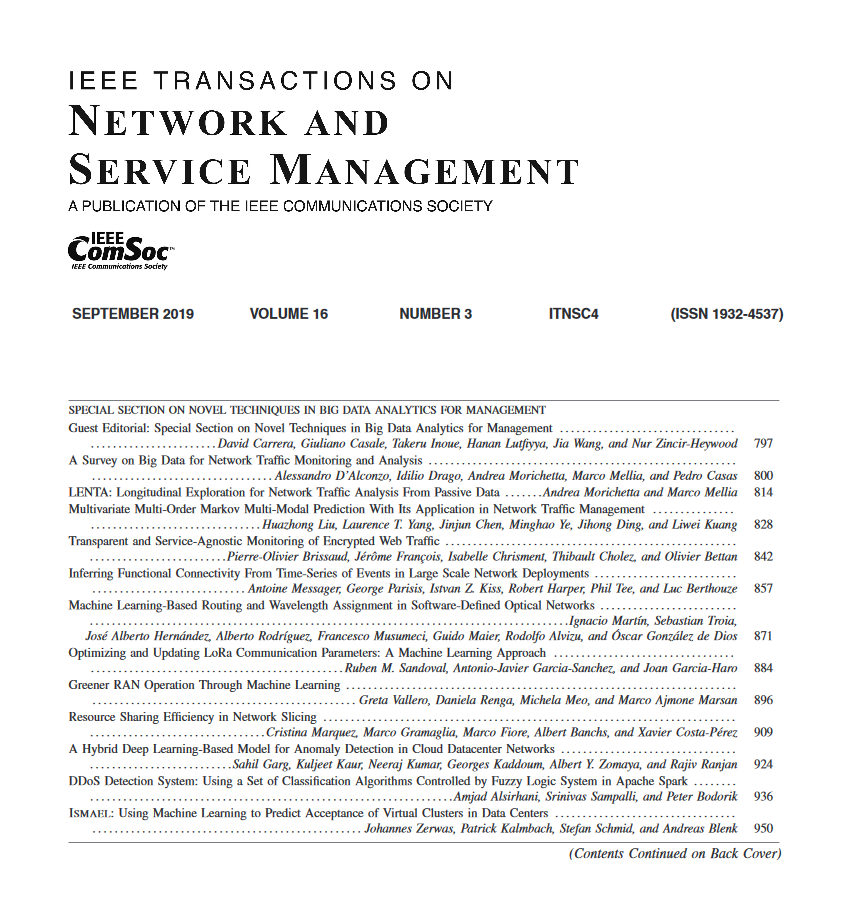Detecting Service Disruptions in Large BGP/MPLS VPN Networks
IF 5.4
2区 计算机科学
Q1 COMPUTER SCIENCE, INFORMATION SYSTEMS
IEEE Transactions on Network and Service Management
Pub Date : 2025-07-11
DOI:10.1109/TNSM.2025.3588314
引用次数: 0
Abstract
This paper presents the result of three years of experience in research, design, and deployment of a complete architecture aimed at automatically identifying service disruptions in large BGP/MPLS VPN networks. We present the main components of a comprehensive architecture that can be operated in production environments, highlighting the requirements that led to their design. We describe the data that are collected from the network using IETF standard protocols, the processing that is performed onto them to detect anomalies, and the scaling aspects that need to be considered when ingesting the large amounts of data that is necessary for the purpose at hand. We report on two and a half years of deployment experience on the Swisscom BGP/MPLS VPN Network services, by analyzing the behavior of our system in the face of actual network incidents. After each incident, we systematically performed post-mortem analyzes. These investigations led us to conclude that the rule-based approaches that are currently used in deployment, supported by a profiling of the VPN customers to fine-tune rule parameters, enables the detection of service disruptions with the required accuracy.大型BGP/MPLS VPN网络业务中断检测
本文介绍了三年研究、设计和部署完整架构的成果,该架构旨在自动识别大型BGP/MPLS VPN网络中的业务中断。我们介绍了可以在生产环境中运行的综合体系结构的主要组件,并强调了导致其设计的需求。我们描述了使用IETF标准协议从网络收集的数据,对它们执行的处理以检测异常,以及在摄取大量数据时需要考虑的扩展方面,这些数据对于手头的目的是必要的。通过分析我们的系统在面对实际网络事件时的行为,我们报告了在Swisscom BGP/MPLS VPN网络服务上两年半的部署经验。每次事故发生后,我们都会系统地进行事后分析。这些调查使我们得出结论,目前在部署中使用的基于规则的方法,通过对VPN客户的分析来微调规则参数,能够以所需的准确性检测服务中断。
本文章由计算机程序翻译,如有差异,请以英文原文为准。
求助全文
约1分钟内获得全文
求助全文
来源期刊

IEEE Transactions on Network and Service Management
Computer Science-Computer Networks and Communications
CiteScore
9.30
自引率
15.10%
发文量
325
期刊介绍:
IEEE Transactions on Network and Service Management will publish (online only) peerreviewed archival quality papers that advance the state-of-the-art and practical applications of network and service management. Theoretical research contributions (presenting new concepts and techniques) and applied contributions (reporting on experiences and experiments with actual systems) will be encouraged. These transactions will focus on the key technical issues related to: Management Models, Architectures and Frameworks; Service Provisioning, Reliability and Quality Assurance; Management Functions; Enabling Technologies; Information and Communication Models; Policies; Applications and Case Studies; Emerging Technologies and Standards.
 求助内容:
求助内容: 应助结果提醒方式:
应助结果提醒方式:


